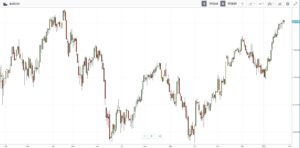The ASX200 wrapped up its 4th consecutive week of gains last week, jumping 0.6 per cent as the index stormed to 9-month highs. After last year’s resilient performance and a strong start to 2023, the index is now just 2 per cent away from record highs. The technology sector led gains last week, up 2.63 per cent thanks to a strong week from the Nasdaq, up 4.71 per cent. It’s a huge week ahead with one of the biggest weeks seen in recent history, from central bank decisions across the globe, including the Fed, BoE and ECB, Non-Farm Payrolls, OPEC gatherings and huge corporate earnings from Apple (APPL), Amazon (AMZN), Alphabet (GOOG) and Meta.
3 things that happened last week:
1. Australian Inflation tops expectations
Last week’s inflation data came in hotter than expected for both Q4 and December’s monthly reading. Although the quarterly reading was below the Reserve Bank of Australia’s (RBA) 8 per cent expectation, it was still higher than most economists had expected. December’s reading was 8.4 per cent, up from the 7.3 per cent in November. All eyes are now on the RBA, with their rate decision just around the corner in February. The potential for a pause in rate rises now looks to be off the cards – and this reading may even prompt the RBA to deliver a 25 basis point hike instead of 15 basis points, with the intention of continuing to raise rates well into 2023. The bottom line is the RBA’s job isn’t over, and unfortunately, they could deliver even more pain to households with ongoing hikes on the cards and the prospect of a soft landing slowly slipping away.
2. Big Tech Earnings: Microsoft guidance disappoints, but Tesla delivers record results
It was a mixed bag for Microsoft (MSFT), with earnings beating expectations but revenue missing the mark with its slowest quarterly growth since 2016 at just 2 per cent year over year. Strength in the report came from its Azure cloud computing business, with sales gaining by 38 per cent, above market expectations. But, after the move higher after the initial report, Microsoft said revenue growth in its Azure cloud-computing business will slow in the current period, and it anticipated a further slowdown in software sales, fueling investor concerns.
Tesla (TSLA) reported record quarterly results in what was one of the most important earnings results in many years. After a year full of drama from Musk’s Twitter purchase, China lockdowns, a harsh bear market and demand question marks, Tesla has reassured investors that production would continue to ramp up, setting a target of 1.8 million vehicles delivered in 2023. Musk flexed his financial muscles on the call, noting Tesla has USD$20 billion cash on hand, a pretty healthy sum to survive whatever this murky economic backdrop throws at them.
3. A winner and loser last week from the S&P/ASX200
Last week saw a turnaround for Liontown Resources (LTR), with shares gaining 17.82 per cent for the week. The lithium miner saw Chair Tim Goyder buy an extra $1.5 million worth of shares last week, which spurred investor optimism.
New Hope Mining lost 13.61 per cent last week as coal prices continue to fall since the start of 2023, weighing on the outlook for miners.
3 things to watch for the week ahead:
1. Fed Interest Rate Decision: Slowing down?
The slowdown in the Fed’s interest rate cycle looks to be on the horizon, with the market expecting Jerome Powell to hand down a 25 basis point hike this week. If a 25 basis point is delivered from the Federal Reserve, it could spell more optimism for markets, given that it would most likely mean that rates hold below 5 per cent, lower than some Fed officials had anticipated in 2022. Markets already believe that we are near the top of the Fed’s rate hike cycle as inflation continues to decline, with the Nasdaq rallying more than 10 per cent to start 2023. Consensus is for two more hikes of 25 basis points in February and March before another decision in May, which could signal a pause. Let’s remember, though, that the Fed has been clear that they need to see more signs of inflation easing. There is obviously progress on inflation, but the Fed wants to be sure it can bring prices under control. So it’s important for investors not to get ahead of themselves, despite a good start to the year, because although a pause may be around the corner, rates will likely stay high until inflation returns to the Fed’s 2 per cent target.
2. Retail Sales AU: Aussies going strong
The Australian consumer has clearly stayed resilient in 2022, but as rate rises and inflation start to pinch, with December’s CPI reading at 8.4 per cent, consumers may start to temper their spending habits in the new year, and retail sales may begin to drop off. This week’s reading of December retail sales (Jan. 30) could round off a strong year for consumer spending, with every month showing gains. Expectations are for a rise of 0.4 per cent for December after November’s strong reading of 1.4 per cent, thanks to Black Friday and Cyber Monday sales. We will be watching if consumer spending continued into the festive period, shopping for presents and eating out. Department store spending continued to rise in November, and could well do the same in December, with Myer reaping the rewards as it posted its strongest sales numbers for 20 years in the last five months of 2022. This December reading will likely show shoppers’ last spending spree from Christmas sales.
3. Australian investors are feeling positive, but inflation and recession a worry
The majority of Australian retail investors are shrugging off the downturn that has gripped financial markets for more than a year, according to our latest Retail Investor Beat survey. There has been an uplift in sentiment, with 77 per cent of the Australians polled feeling confident about their portfolios. It might be surprising to see investors so upbeat after a difficult year for investing, but the majority of this cohort think in years and decades – and the ASX200 performed better than most major markets in 2022. When asked about the biggest risk across the whole of 2023, those citing inflation came in at 16 per cent, with more (24 per cent) seeing a global recession as the main threat. Investors will know that inflation may not have peaked in Australia and is well above the RBA’s target. The hot inflation reading last week will also mean that rates will now rise again, after a pause was potentially on the cards. But, shrewd retail investors are still clearly investing for their future and maintaining long-term mindsets – primarily by steadily raising their investments in equities and more defensive asset classes.
All data accurate as of 30/01/2023. Data Source: Bloomberg and eToro
Disclaimer:
This communication is general information and education purposes only and should not be taken as financial product advice, a personal recommendation, or an offer of, or solicitation to buy or sell, any financial product. It has been prepared without taking your objectives, financial situation or needs into account. Any references to past performance and future indications are not, and should not be taken as, a reliable indicator of future results. eToro makes no representation and assumes no liability as to the accuracy or completeness of the content of this publication.




